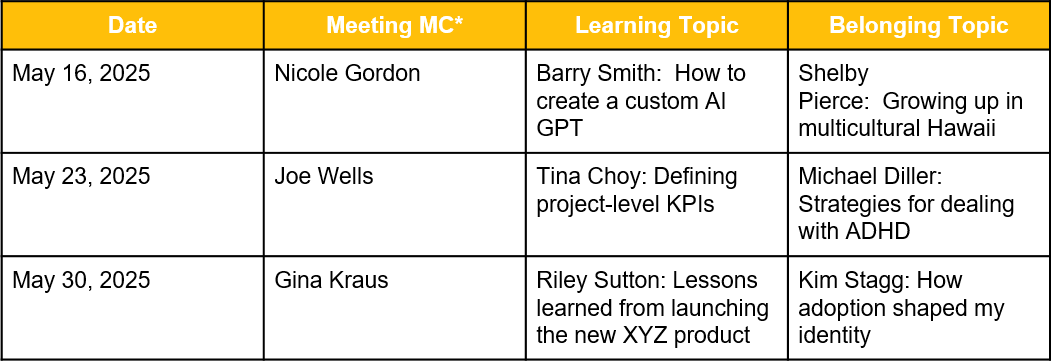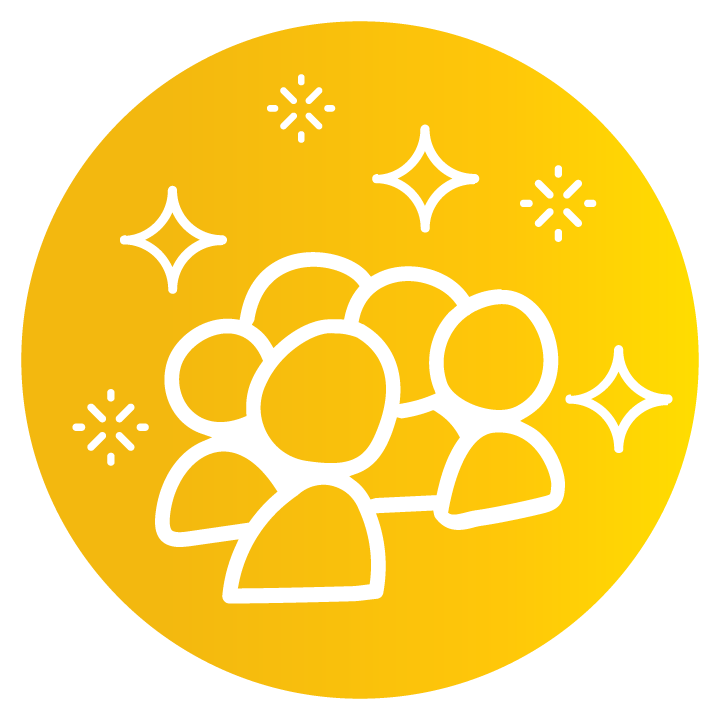Team Culture Isn’t Built in a Day - But It Can Be Built in One Hour a Week
A simple, powerful blueprint for designing all-hands meetings that foster learning, belonging, and engagement
Being a people leader has always been challenging but, today, the stakes are higher and the challenges deeper. You are likely navigating one, two, or, if you are lucky (ha!) all three:
Workforce reductions (RIFs) and layoffs
Return-to-office mandates
DEI commitment rollback and cultural whiplash
In my article, What Do Middle Managers Do? I argued that middle managers are strategic executors, emotional shock absorbers, and culture creators. You walk the tightrope of aligning with corporate priorities while protecting the team's morale and mental well-being. It’s not easy. But it’s essential.

Because here’s the truth:
Feeling a sense of connection, mattering, and belonging are core human needs isn’t a “nice to have”—it’s a biological necessity, as vital as air or water. Everyone wants to feel that what they work on together everyday has meaning. And one of your most powerful jobs as a leader is to weave a thread between your organization’s strategy and each team member’s contributions. But it doesn’t stop there. You can do more—and it starts with how you gather your team.
Reframing the Leadership Challenge
Instead of asking stale and honestly meaningless questions like “How can we grow 10x?” I invite you to make inquiries of yourself and the leaders around you that I believe are far more urgent and human:
What do people need right now?
What does effective leadership look like in a time of constant disruption?
What can I actually control in a world that feels out of control?
How can I create islands of sanity in my workplace—and lead from there?
“In a world we cannot recognize, how do we find a way forward? In this world we do not understand, how do we know what to do? When so little is comprehensible, what is meaningful work, what is genuine contribution?”
There are infinite intentional moves leaders can make to foster connection and clarity. But this post focuses on one deceptively simple, deeply effective lever: the design of your all-hands team meeting.
Your Sphere of Influence
Use the Sphere of Influence framework to guide your thinking. This is the space where you can create the conditions for others to thrive. This is where culture is built—not through company-wide initiatives, but through everyday interactions, rituals, and practices.
This is where we build what Margaret Wheatley calls islands of sanity, microcultures where people feel seen, safe, and motivated.
All-hands Meetings with Heart and Soul
Below is a concrete, repeatable design for an all-hands meeting that fosters learning, belonging, and a culture of appreciation. Explore, use, and adapt this blueprint to increase engagement and safety in the midst of chaos.
Spoiler: This one-hour meeting could become the most energizing part of your team’s week.
Scheduling
Make it regular. Weekly if possible. Really take advantage of the community-building space to meet, connect and engage.
In my last corporate role, we met Fridays at 9 a.m. My co-leader Mark McCormick1 called it “the one hour at work you’ll actually look forward to every week.” He was right.
If you manage other managers, co-create this format with them so they feel ownership—and less like it’s “one more thing.” Try saying:
“I’ve been reflecting on the energy and usefulness of our team meetings and want to make them more engaging. Here are some ideas—I'd love to hear yours.”
Share the stage
Great leaders don’t center themselves—they distribute power.
Shift from “my meeting” to “our meeting.” Rotate roles. Invite participation. This isn’t a performance. It’s a community practice and a playground for team members to work on meeting facilitation and presentation skills.
Create a shared signup sheet for key roles:
Set expectations that everyone will contribute at least once a quarter (or whatever cadence makes sense for your team size). You might want to model the MC role first before handing it off to the broader team.
Agenda Blueprint
The meeting agenda will remain consistent even as the topics change.
Run of Show
The MC opens the meeting with warmth and levity. The MC can make this their own by sharing trivia / fun facts / famous birthdays - “it’s National bake a cake day which is great because it’s also Barbara Streisand’s birthday so be sure to bake a cake for Babs when you get home.”
The MC could also do a random-question team poll (popcorn style - not everyone has to share): "What’s your weirdest shopping return story?"2 The MC should also make any team announcements like upcoming mandatory training deadlines, reminders to track time if that’s a thing, and provide an overview of the agenda.
Next, the MC cedes the floor to the Learning Topic presenter. This can be project-based (e.g.,”this is how we did it”) or a deeper dive into a tool or skill. It’s a peer-teaching moment that builds competence and confidence across the team.
Then comes the palate cleanser: Recognition.
First, any formal updates—promotions, launches, milestones—typically announced by the person’s direct manager.
Then, open the floor for informal appreciation: peer-to-peer shout-outs, thank-yous, and “you made my week easier” moments. Here’s where people name the good, out loud. It’s powerful.
“I want to recognize Heather for the workshop facilitation last week—it helped us align and reframe our thinking. Thank you!”
This normalizes asking for and offering help—something Phyl Terry teaches thousands so beautifully through Collaborative Gain and Never Search Alone. Leaders who ask for help don’t appear weak—they grow stronger and go farther. As the African proverb says:
“If you want to go fast, go alone.
If you want to go far, go together.”
The goal of formal and informal recognition is to build a culture of care, gratitude, and helping one another. The MC will need to manage time since this could get a little long - “we have time for one more informal recognition announcement…going once, going twice…”
Finally, the Belonging Topic. A team member shares something important to them. It could be a personal story, cultural identity, volunteer work, or a favorite hobby. No pressure to be vulnerable—just real. Every employee has unique life experiences and every human has a fundamental need to be known and to belong.
This 15-minute practice nurtures empathy, connection, and humanity at work—especially critical now as formal DEI programs are scaled back, which leaders have shared with me candidly is having a negative affect on employee morale.
As a leader you can deepen relationships and a culture of care – the bedrock conditions for collaboration, learning, and innovation - by carving out space for people to share who they are and what they care about.
The Leadership Power Hour
Let’s bring it home.
In a world spinning with uncertainty, one thing remains within your reach: the ability to shape how your team experiences work. You can create an hour each week that’s rooted in humanity and connection—an hour that reminds people they matter.
Don’t underestimate the power of that.
Culture isn’t built in expensive offsites or strategy decks. It’s built in the consistent, courageous container you create each week.
Start with one hour. Start now. Create your island of sanity.
Please share this post far and wide! Hit subscribe and tell your friends and colleagues about The Soft Stuff is the Hard Stuff.
Got a leadership, team, or organizational challenge you want to discuss? I’m a great listener. Schedule a complimentary 30-minutes.
Robin Beers, PhD (she/her) is an Organizational Psychologist and the founder of Ubuntu Culture Company. Robin partners with brave, caring leaders to navigate this era of perpetual upheaval and guides them to develop cultures, strategies, and capabilities to thrive in uncertain times. Leveraging 25+ years of corporate leadership experience she creates value through approaching organizations as connected systems, a deep understanding of human behavior, and an incisive ability to diagnose where organizations need to learn, change, and adapt. The result is workplaces where employees can contribute fully, collaborate fearlessly, and unleash innovative potential to enable the organization to thrive.
I learned so many profound leadership lessons working closely with Mark. He is also a talented painter and writer, you can find his substack here: verymarkmccormick
Can I just advise you not to buy solar paper lanterns from some random site in the UK? Yes, I know, they keep showing up in your Instagram feed and would look so colorful and romantic strung around your outdoor space but, trust me, they are flimsy, impossible to put together, and you will be stuck paying for shipping back across the Atlantic. Ask me how I know.








Thanks for the shout-out Robin. I'm glad to see you writing about this topic and tying it in with the role of the middle manager; you're right to point out that the middle manager has the unique opportunity--I would even call it a responsibility--to "weave a thread" between strategy and contribution, or between business goals and belonging. Because guess what: if people don't feel like they belong--they leave! Middle management in some ways is a thankless position unless you play it right. Upper management might see you as critical in delivering their KPIs but no more than that, while lower management and individual contributors might see you as a tool. UNLESS you do what's described: build a rich culture where people want to *stay* and deliver their best work. The team meeting is a canvas where you can create the culture *you* want, and your blueprint really works. It drives retention and good work.
And here's what I know: years (even decades) after someone has moved on from your group for whatever reason, or after the team gets redistributed due to some re-org (it happens), what people will remember is the team meeting! Make it consistent, make it fun, make it inclusionary and participatory, make it worthwhile, make it meaningful, make it matter.